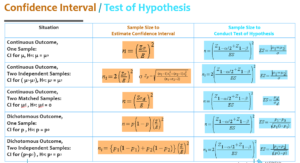Need: Before conducting any experiment, we need to select the appropriate and optimum sample size to make sure sample should be representative of the population and the finding are generalized to the population. Also, optimum sample size required
- To Allow appropriate analysis
- To provide desire level of accuracy
- To allow the validly to the significance test
Approach: Sample size determination is depending on few factors like primary outcome of the study, past clinical information and statistical information
The primary outcome of the study consists, type of the study design, level of measurements and no of groups like mentioned below.

The clinical information requires some pseudo estimates on prevalence, accuracy and effects sizes, which generally we will get from clinical literature or sometimes from pilot studies.

The statistical information requires are Type 1 error (alpha)for setting the confidence and Power to detect the differences.

Once we have these information’s, on the basis of primary objects we have different formulas to find the optimum sample size which valid for both clinically and statistically

But we do have lot of online tools which can take these information and provide the sample sizes.
The below is one source for calculation sample sizes.
Sample size for all kinds of studies
https://epitools.ausvet.com.au/oneproportion
Source: https://www.youtube.com/watch?v=J3VsH9Q-uKc



